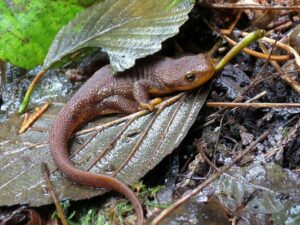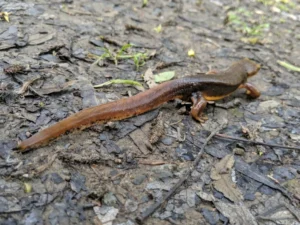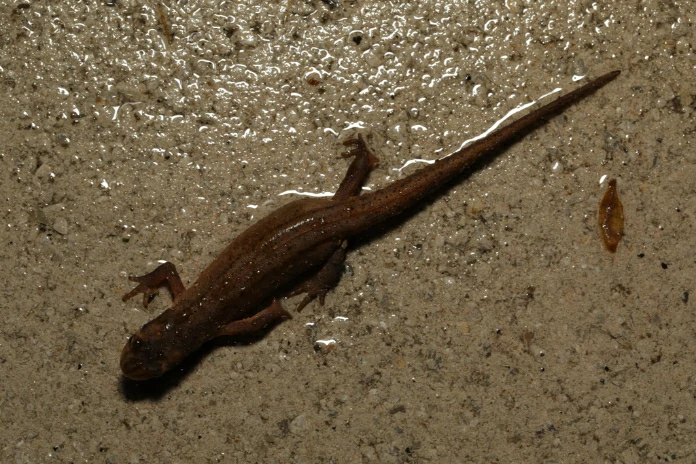You’re walking along a quiet pond just after sunset and you spot a newt. That makes you wonder: are newts really more active at night?
Most newts are nocturnal or crepuscular, meaning they move and hunt mostly in the evening, night, and early morning. This nighttime activity helps them stay safe from predators and find food when fewer creatures are around.
During the day, newts usually hide under leaves, logs, or rocks. But after sunset, they get braver, moving into shallow water or along the muddy edges of the pond.
Why Newts Prefer the Night Instead of Daylight
Have you noticed how quiet a pond gets after the sun goes down? That quiet is perfect for a newt.
They can’t hear sounds traveling through the air clearly, so being out when fewer creatures are moving around makes them safer.

Night also brings cooler temperatures and more moisture, which makes moving easier for their sensitive skin.
Newts’ skin is thin and moist, so they can lose water quickly. Moving at night keeps them from drying out in the sun.
Basically, darkness gives them freedom to move without the risk of losing water.
Even more, night is when many of their prey are most active. Worms, insects, and slugs come out under the cover of darkness.
A newt hunting at night has more chances to find food without competing with birds or bigger predators.
Which Newt Species Are Most Active at Night and Which Are Not?
Not all newts are equally nocturnal. Some species, like the Eastern newt, spend long periods in water and move mostly at night.

Other species, like the Fire-bellied newt, are sometimes active in the late afternoon or early morning.
That makes them crepuscular (active around dawn and dusk) rather than strictly nocturnal.
In cooler climates, a newt may change when it moves depending on the season. During warm summer nights, it might move around freely.
But in cooler weather, even at night, it may slow down and hide under leaves or submerged logs.
So, while night is usually their preferred time, newts are flexible. They respond to temperature, moisture, and safety instead of following a strict clock.
How Newts Hunt Worms and Insects During Nighttime
Newts rely a lot on touch and chemical senses to find food. They have sensitive skin and a strong sense of smell in the water, which helps them detect prey even when it’s too dark to see clearly.
Their eyes are adapted for low light, so they can spot movement without needing bright light.

You might actually see a newt slowly approach a worm or small insect at night, pause, and then strike quickly. This slow, careful hunting style works best in low light.
During the day, bright sunlight makes it easier for predators to spot them, so hunting then would be risky.
Where Do Newts Hide During the Day?
During the day, newts usually stay hidden. They tuck themselves under leaves, logs, rocks, or mud. This hiding isn’t laziness; it’s survival.
Predators like birds, snakes, or bigger amphibians are more active during daylight, and newts have to avoid them.

Even when they are in the water during the day, newts tend to stay near plants or in shaded areas.
The water near the surface may be too warm or dry for their skin, so hiding helps them stay safe and hydrated.
Basically, daytime is for resting and waiting. Nighttime is for exploring, hunting, and moving freely.
How Temperature and Moisture Change Newts’ Nighttime Activity
You might think a newt is nocturnal no matter what, but it’s actually more complicated. Conditions in the environment play a big role in when they move.
- Temperature: Newts are cold-blooded. If it’s too hot or too cold, movement stops. Nighttime often gives moderate temperatures, perfect for moving.
- Moisture: Wet nights are ideal because newts need moisture to move safely. Rainy evenings can bring them out in larger numbers.
- Predators: Areas with many daytime predators push newts to be more nocturnal. They learn to move when it’s safest.
This flexibility makes newts very good at adjusting to their environment. They might not follow the clock exactly, but they find the best times to hunt and explore safely.
Do Other Amphibians Move at Night Like Newts?
You may wonder if other amphibians act like newts. Frogs, for example, are also mostly nocturnal. Toads tend to move at night, especially after rain.
Salamanders, which are close relatives of newts, often have similar habits.
Still, there are exceptions. Some frogs and salamanders may be active during the day in wet, shady forests.
But generally, moving at night is safer for most amphibians with delicate skin.
How Newts’ Activity Changes With the Seasons
You might wonder if newts stay nocturnal all year. Actually, their activity changes with the seasons.
-
Spring and summer: Warmer nights bring more movement. Mating and hunting happen mostly at night.
-
Autumn: Cooler nights and wetter conditions keep them active, but they start getting ready for winter.
-
Winter: In very cold places, movement stops almost completely. Newts hibernate under mud or leaves, but life continues inside their cells. Nighttime activity is mostly paused until temperatures rise.
So, their night habits are strongest when conditions let them move safely and easily.
Can Newts Ever Be Seen During the Day?
Yes, but it’s rare. You might see a newt during the day after rain when the ground is wet and shady. Even then, they move cautiously and usually stay under leaves or near water.

Some species are a little more active in the early morning or late afternoon. This crepuscular behavior is a compromise between safety and opportunity.
Basically, newts adjust when they move to fit the safest and most productive times.
How Nighttime Activity Changes During Mating Season
Mating season gives newts another reason to be out at night. Male newts often show bright colors or wave their tails in water to attract females.
Nighttime gives them privacy and protection while showing off.
Female newts also move more at night during breeding season, looking for males and safe spots to lay eggs.
Watching a pond at night then, you might see more movement than usual.
Nighttime is simply the best time for social activity and reproduction without putting themselves at too much risk.
How to Watch Newts at Night Without Disturbing Them
If you want to watch newts, night is the best time. A few tips:
-
Use a red flashlight or dim light. Bright lights can scare them.
-
Move slowly and avoid splashing in the water.
-
Look under leaves, logs, or along shallow water edges.
-
Don’t touch them too much; handling can stress them or hurt their skin.
Watching newts at night can be quiet and peaceful. You see them doing what they really need to survive, hunt, and reproduce.
Conclusion
So, are newts nocturnal? Yes, mostly. They move and hunt at night to stay safe, stay moist, and find food more easily.
Their nighttime activity is shaped by predators, temperature, moisture, and seasonal changes.
During the day, newts hide under logs, leaves, or in shallow water to avoid danger. Nighttime gives them freedom to explore, hunt, and even mate.
Their sensitive skin, careful hunting style, and small size make night activity not just a choice, but a way to survive.
Next time you pass a pond after dark, look carefully. You might spot a newt gliding quietly, tail swaying, moving slowly but confidently.
Nighttime is their time to shine, and their careful movements remind us how much the night matters for survival in the natural world.
Hi, my name is Ezra Mushala, i have been interested animals all my life. I am the main author and editor here at snakeinformer.com.

